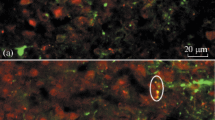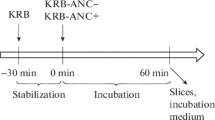Abstract—
Dopamine (DA), which is synthesized in DA-ergic neurons and so-called monoenzymatic neurons, is involved in the regulation of neuronal differentiation during the critical period of morphogenesis. The aim of the present study was to examine phenotypic features of DA-producing neurons in several brain regions, including the striatum, suprachiasmatic nucleus, and arcuate nucleus, during rat ontogeny starting from embryonic day 18 (E18) to postnatal day 60 (P60). The enzymes of DA synthesis tyrosine hydroxylase (TH) and aromatic amino acid decarboxylase (AAAD), vesicular monoamine transporters (VMAT), and D1 and D2 DA receptors were used as markers for functional activity of DA neurons. Expression of these markers was studied using double immunohistochemical labeling of TH and AAAD or PCR assay of TH, AAAD, VMAT1, VMAT2, and D1 and D2 DA receptors. In the striatum, mRNAs of all mentioned markers were revealed within the whole period of ontogeny studied, bienzymatic TH and AAAD-immunopositive neurons were observed at E18, whereas monoenzymatic TH- or AAAD-containing neurons were observed at P60 only. In the suprachiasmatic nucleus, monoenzymatic AAAD neurons coexist with monoenzymatic TH-immunoreactive fibers, which innervate the ventral part of the nucleus, in the early postnatal period (P10). At P10 in the suprachiasmatic nucleus, the TH, VMAT1, and VMAT2 genes are not expressed; however, transcripts of the D1 and D2 genes were detected. The arcuate nucleus of rat embryos contained only monoenzymatic TH neurons in the ventrolateral area and AAAD neurons in the dorsomedial area in the late prenatal period (E21). At the same time TH, AAAD, VMAT2, D1, and D2 mRNAs were expressed in both parts of the arcuate nucleus. Thus, during rat ontogeny, nondopaminergic neurons containing one of the enzymes, TH or AAAD, are present in the striatum, suprachiasmatic nucleus, and arcuate nucleus, which allows for suggesting the cooperative synthesis of dopamine in these brain structures.





Similar content being viewed by others
REFERENCES
Beltramo, M., Calas, M., Chernigovskaya, E., et al., Postnatal development of the suprachiasmatic nucleus in the rat. Morpho-functional characteristics and time course of tyrosine hydroxylase immunopositive fibers, Neuroscience, 1994, vol. 63, no. 2, pp. 603–610.
Berry, M.D., Juorio, A.V., Li, X.-M., et al., Aromatic L‑amino acid decarboxylase: a neglected and misunderstood enzyme, Neurochem. Res., 1996, vol. 21, no. 9, pp. 1075–1087.
Bookout, A., Cummins, C., Mangelsdorf, D., et al., High-throughput real-time quantitative reverse transcription PCR, Curr. Protoc. Mol. Biol., 2006, pp. 15.8.1–15.8.28.
Bupesh, M., Vicario, A., Abellan, A., et al., Dynamic expression of tyrosine hydroxylase mRNA and protein in neurons of the striatum and amygdala of mice, and experimental evidence of their multiple embryonic origin, Brain Struct. Funct., 2014, vol. 219, no. 3, pp. 751–776.
Buscetti, C.L., Bucci, D., Molinaro, G., et al., Lack or inhibition of dopaminergic stimulation induces a development increase of striatal tyrosine hydroxylase-positive interneurons, PLoS One, 2012, vol. 7, no. 9. e44025.
Duffield, G.E., McNulty, S., and Ebling, F.J.P., Anatomical and functional characterisation of a dopaminergic system in the suprachiasmatic nucleus of the neonatal Siberian hamster, J. Comp. Neurol., 1999, vol. 408, pp. 73–96.
Ershov, P., Ugrumov, M.V., Calas, A., et al., Neurons possessing enzymes of dopamine synthesis in the mediobasal hypothalamus of rats: topographic relations and axonal projections to the median eminence in ontogenesis, J. Chem. Neuroanat., 2002, vol. 24, no. 2, pp. 95–107.
Gallardo, C.M., Darvas, M., Oviatt, M., et al., Dopamine receptor 1 neurons in the dorsal striatum regulate food anticipatory circadian activity rhythms in mice, Elife, 2014, vol. 3. e03781.
Gaspar, P., Cases, O., and Maroteaux, L., The developmental role of serotonin: news from mouse molecular genetics, Nat. Rev. Neurosci., 2003, vol. 4, pp. 1002–1102.
Hansson, S.R., Hoffman, B.J., and Mezey, E., Ontogeny of vesicular monoamine transporter mRNAs VMAT1 and VMAT2: I. The developing rat central nervous system, Brain Res. Dev. Brain. Res., 1998, vol. 110, no. 1, pp. 135–158.
Hoffman, B.J., Hansson, S.R., Mezey, E., and Palkovits, M., Localization and dynamic regulation of biogenic amine transporters in the mammalian central nervous system, Front. Neuroendocrinol., 1998, vol. 19, pp. 187–231.
Ibáñez-Sandoval, O., Tecuapetla, F., Unal, B., et al., Electrophysiological and morphological characteristics and synaptic connectivity of tyrosine hydroxylase-expressing neurons in adult mouse striatum, J. Neurosci., 2010, vol. 30, pp. 6999–7016.
Izvolskaya, M.S., Adamskaya, E.I., Voronova, S.N., et al., Catecholamines in regulation of development of GnRH neurons of rat fetuses, Russ. J. Dev. Biol., 2005, vol. 36, no. 6, pp. 369–376.
Jaeger, C.B., Albert, V.R., Joh, T.H., et al., Aromatic L-amino acid decarboxylase in the rat brain: coexistence with vasopressin in small neurons of the suprachiasmatic nucleus, Brain Res., 1983, vol. 276, no. 2, pp. 362–366.
Kozina, E.A., Khakimova, G.R., Khaindrava, V.G., et al., Tyrosine hydroxylase expression and activity in the nigrostriatal dopaminergic neurons of MPTP-treated mice at the presymptomatic and symptomatic stages of parkinsonism, J. Neurol. Sci., 2014, vol. 340, pp. 198–207.
Kozina, E.A., Kim, A.R., Kurina, A.Y., and Ugrumov, M.V., Cooperative synthesis of dopamine by non-dopaminergic neurons as a compensatory mechanism in the striatum of mice with MPTP-induced parkinsonism, Neurobiol. Dis., 2017, vol. 98, pp. 108–121.
Mirochnik, V.V., Makarenko, I.G., and Ugryumov, M.V., The source of transitory innervation of suprachiasmatic nucleus by tyrosine hydroxylase-immunoreactive fibers during postnatal period in rats, Russ. J. Dev. Biol., 2002, vol. 33, no. 3, pp. 147–150.
Mura, A., Jackson, D., Manley, M.S., et al., Aromatic L‑amino acid decarboxylase immunoreactive cells in the rat striatum: a possible site for the conversion of exogenous L-DOPA to dopamine, Brain Res., 1995, vol. 704, pp. 51–60.
Pronina, T., Ugrumov, M., Calas, A., et al., Influence of monoamine on differentiating gonadotropin-releasing hormone neurones in foetal mice, J. Neuroendocrinol., 2003, vol. 15, pp. 925–932.
Schafer, M.K.-H., Weihe, E., and Eiden, L.E., Localization and expression of VMAT2 across mammalian species: a translational guide for its visualization and targeting in health and disease, Adv. Pharmacol., 2013, vol. 68, pp. 319–334.
Ugrumov, M.V., Non-dopaminergic neurons partly expressing dopaminergic phenotype: distribution in the brain, development and functional significance, J. Chem. Neuroanat., 2009, vol. 38, pp. 241–256.
Ugrumov, M.V., Developing brain as an endocrine organ: paradoxical reality, Neurochem. Res., 2010, vol. 35, pp. 837–850.
Ugrumov, M.V., Brain neurons partly expressing dopaminergic phenotype: location, development, functional significance, and regulation, Adv. Pharmacol., 2013, vol. 68, pp. 37–91.
Ugrumov, M.V., Melnikova, V.I., Lavrentyeva, A.V., et al., Dopamine synthesis by non-dopaminergic neurons expressing individual complementary enzymes of the dopamine synthetic pathway in the arcuate nucleus of fetal rats, Neuroscience, 2004, vol. 124, no. 3, pp. 629–635.
Xenias, H.S., Ibáñez-Sandoval, O., Koós, T., and Tepper, J.M., Are striatal tyrosine hydroxylase interneurons dopaminergic?, J. Neurosci., 2015, vol. 35, pp. 6584–6599.
Funding
This study was supported by the Russian Science Foundation, project no. 17-14-01422.
Author information
Authors and Affiliations
Corresponding author
Ethics declarations
Conflict of interests. The authors declare that they have no conflict of interest.
Statement on the welfare of animals. All applicable international, national, and/or institutional guidelines for the care and use of animals were followed.
Additional information
Translated by M. Stepanichev
Rights and permissions
About this article
Cite this article
Kurtova, A.I., Dil’mukhametova, L.K., Pronina, T.S. et al. Dopamine-Producing Neurons in Rat Ontogeny: Phenotypic Features Underlying Molecular Mechanisms of Secretion and Regulation. Russ J Dev Biol 51, 57–64 (2020). https://doi.org/10.1134/S1062360420010038
Received:
Revised:
Accepted:
Published:
Issue Date:
DOI: https://doi.org/10.1134/S1062360420010038




